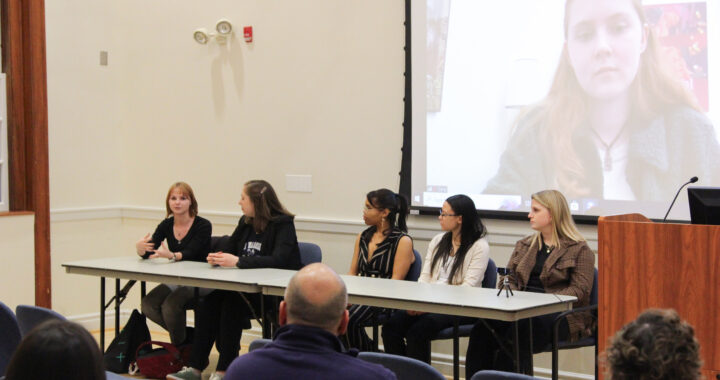Flu Cases Double in One Week; Number Hits 142
4 min readThe Student Health Center has seen 142 cases of influenza-like illness as of Tuesday night, Oct. 27.
According to Tom Riley, director of the Health Center and university physician, the actual number of flu cases is probably much higher due to students that become ill but do not go to the Health Center for treatment.
“The number of cases in a typical flu epidemic follows a classic bell shaped curve over a two to three week period,” Riley said. “We should be reaching the peak soon, followed by a decline.”
Students are diagnosed with influenza-like illness, or ILI, based on their symptoms. According to Riley, the Virginia Department of Health’s instructions to the Health Center two months ago were that it could be more reliable to count cases of ILI than to use the in-office rapid-tests, which are considered unreliable.
“This has not changed,” Riley said. “According to the [Center for Disease Control], 97 percent of cases of ILI at this time of year are due to the 2009 H1N1 virus. The regular seasonal flu and the 2009 H1N1 flu have the same symptoms, but the regular seasonal flu is not usually active this time of year.”
Erin Perugini, a junior resident of Willard Hall, was one of the 142 students diagnosed with the flu.
“I got it from my roommate, Alaina, even though I slept with a mask on and spent limited time in the room and Lysol-ed the hell out of the place,” Perugini said.
Perugini started feeling sick Saturday evening, Oct. 24 and went to the Health Center the following Monday morning.
“There wasn’t a line, and [the Health Center employees] were very good about everything,” Perugini said. “They did make you wear a mask in the waiting room, making you feel like you had the plague. But they had bought a prescription of Tessalon Perles that they gave me for free, as well as Sudafed for my headache.”
Perugini’s roommate, sophomore Alaina Esposito, said she only waited in the Health Center for five minutes before being seen. Within two minutes of talking with a nurse, Esposito said she was diagnosed with swine flu.
“The nurse told me I had classic symptoms of swine flu,” Esposito said, “and that there was no need for her to test me because the test would have cost me extra money, it’s not 100 percent accurate, and they will treat me the same way even if it was negative.”
Esposito added that the day she was diagnosed with the flu, Friday Oct. 23, the nurse told her that the Health Center had seen about 200 students that week, 100 of which were diagnosed cases of swine flu.
Riley confirmed the dramatic increase in the number of students the Health Center has experienced recently.
“We are seeing more visits in the [Health Center] now, for all reasons including the flu, than during any time in the last two and a half years that I have been here,” Riley said.
According to Riley, the flu symptoms students are experiencing now aren’t any worse than what he usually sees during the “seasonal flu epidemic” that students experience each year.
“What is different is the number of cases and the time of year,” Riley said. “More people are susceptible to this flu so we are seeing more, but not worse, cases than the seasonal flu.”
“October is an unusual month for a flu outbreak,” he added. “Usually the epidemic is in January or February, so we may have another outbreak with the seasonal flu later this winter.”
Both Esposito and Perugini stayed on campus and chose to self-isolate, instead of going home to recover.
“The nurse at the health center recommended that I go home, but I decided to stay at school because I did not want to get my whole family sick,” Esposito said. “From Friday until Monday, I stayed in my room. The only person who I knowingly spread it to was my roommate.”
“I live over 200 miles away in New Jersey, and my roommate had already had the flu, so [there was] no point in leaving,” Perugini said.
“People always treat you differently when you are sick,” Esposito said of the experience. “They don’t want to get too close for fear of catching it themselves.”
Esposito has found humor in the experience, however.
“Someone wrote ‘Oink Oink’ all over my dry erase board and tied a face mask from the Health Center onto my doorknob,” Esposito said. “This probably freaked my neighbors out…My healthy friends never came to visit while I was sick, but my other sick friends would come over and play N64 with my roommate and I. We called these ‘invalid parties.’”
“My room has become a haven for sick people,” Perugini said. “We had two swine flu victims, a strep throat, and someone with a chest cold all playing Mario Kart in here.”
“Other universities and colleges around the country have been having surges of the flu,” Riley said. “It was only a matter of time before the epidemic hit UMW, so we have been waiting for it.”
UMW has not received the swine flu vaccine yet from the federal government, according to Riley.
“There have been manufacturing difficulties limiting the supply and we do not know when the vaccine will be available,” Riley said. “The problem is at the manufacturers’ level, not the federal or state government.”
The federal government has ordered the vaccine, Riley said. It will be free to students when it arrives.











